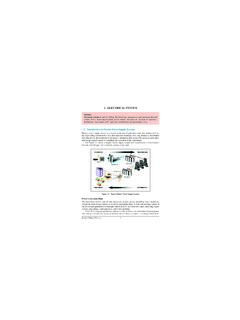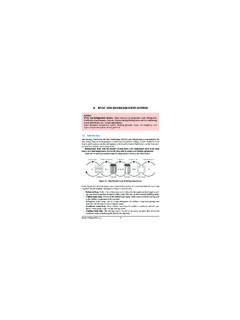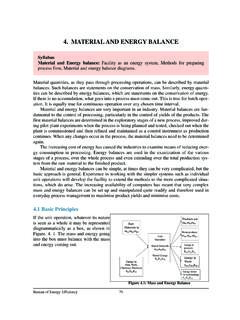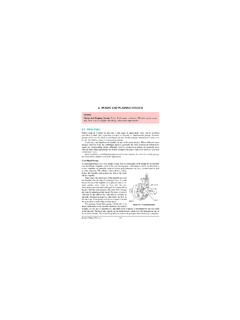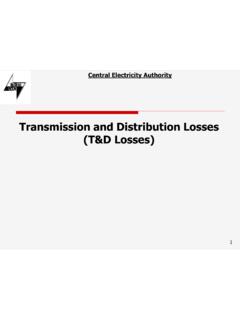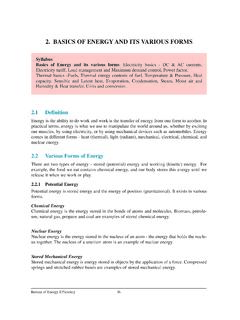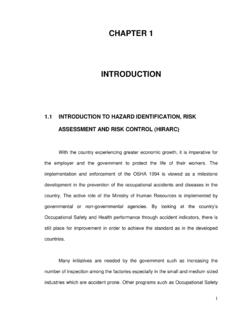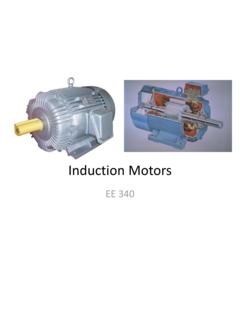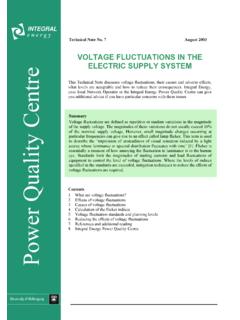Transcription of 4 FURNACES - Bureau of Energy Efficiency
1 4 FURNACES89 Bureau of Energy EfficiencySyllabusFurnaces:Classificatio n, General fuel economy measures in FURNACES , Excess air, Heatdistribution, Temperature control, Draft control, Waste heat furnace is an equipment to melt metals for casting or heat materials for change of shape(rolling, forging etc) or change of properties (heat treatment). Types and Classification of Different FurnacesBased on the method of generating heat, FURNACES are broadly classified into two types namelycombustion type (using fuels) and electric type. In case of combustion type furnace , dependingupon the kind of combustion, it can be broadly classified as oil fired, coal fired or gas fired. Based on the mode of charging of material FURNACES can be classified as (i) Intermittent orBatch type furnace or Periodical furnace and (ii) Continuous furnace .
2 Based on mode of waste heat recovery as recuperative and regenerative FURNACES . Another type of furnace classification is made based on mode of heat transfer, mode ofcharging and mode of heat recovery as shown in the Figure of an Efficient FurnaceFurnace should be designed so that in a given time, as much of material as possible can be heated to an uniform temperature as possible with the least possible fuel and labour. To achieve furnace classification According to mode of heat transfer According to mode of charging According to mode of heat recovery Open fire place furnace Heated through Medium Batch Forging Re-rolling (Batch / continuous pusher) Pot Continuous Glass tank melting (regenerative / recuperative) Recuperative Regenerative Figure : furnace 2/23/2005 5:22 PM Page 89this end, the following parameters can be considered.
3 Determination of the quantity of heat to be imparted to the material or charge. Liberation of sufficient heat within the furnace to heat the stock and overcome all heat losses. Transfer of available part of that heat from the furnace gases to the surface of the heatingstock. Equalisation of the temperature within the stock. Reduction of heat losses from the furnace to the minimum possible extent. furnace Energy SupplySince the products of flue gases directly contact the stock, type of fuel chosen is of example, some materials will not tolerate sulphur in the fuel. Also use of solid fuels willgenerate particulate matter, which will interfere the stock place inside the furnace . Hence, vastmajority of the FURNACES use liquid fuel, gaseous fuel or electricity as Energy FURNACES for steel, cast iron use electricity in induction and arc FURNACES .
4 Non-ferrous melting utilizes oil as Fired FurnaceFurnace oil is the major fuel used in oil fired FURNACES , especially for reheating and heat treatment of materials. LDO is used in FURNACES where presence of sulphur is undesirable. Thekey to efficient furnace operation lies in complete combustion of fuel with minimum excess air. FURNACES operate with efficiencies as low as 7% as against upto 90% achievable in other combustion equipment such as boiler. This is because of the high temperature at which the furnaceshave to operate to meet the required demand. For example, a furnace heating the stock to 1200 Cwill have its exhaust gases leaving atleast at 1200 C resulting in a huge heat loss through the , improvements in efficiencies have been brought about by methods such as preheating ofstock, preheating of combustion air and other waste heat recovery furnace Systemi) Forging FurnacesThe forging furnace is used for preheating billets and ingots to attain a forge temperature.
5 The furnace temperature is maintained at around 1200 to 1250 C. Forging FURNACES , use an openfireplace system and most of the heat is transmitted by radiation. The typical loading in a forging furnace is 5 to 6 tonnes with the furnace operating for 16 to 18 hours daily. The totaloperating cycle can be divided into (i) heat-up time (ii) soaking time and (iii) forging fuel consumption depends upon the type of material and number of reheats required. Rerolling Mill Furnacea) Batch typeA box type furnace is employed for batch type rerolling mill. The furnace is basically used forheating up scrap, small ingots and billets weighing 2 to 20 kg. for rerolling. The charging anddischarging of the material is done manually and the final product is in the form of rods, stripsetc. The operating temperature is about 1200 oC.
6 The total cycle time can be further categorized into heat-up time and rerolling time. During heat-up time the material gets heated4. Furnaces90 Bureau of Energy 2/23/2005 5:22 PM Page 90upto the required temperature and is removed manually for rerolling. The average output fromthese FURNACES varies from 10 to 15 tonnes / day and the specific fuel consumption varies from180 to 280 kg. of coal / tonne of heated ) Continuous Pusher Type:The process flow and operating cycles of a continuous pusher type is the same as that of the batchfurnace. The operating temperature is about 1250 C. Generally, these FURNACES operate 8 to 10hours with an output of 20 to 25 tonnes per day. The material or stock recovers a part of the heat influe gases as it moves down the length of the furnace . Heat absorption by the material in the furnace is slow, steady and uniform throughout the cross-section compared with batch ) Continuous Steel Reheating FurnacesThe main function of a reheating furnace is to raise the temperature of a piece of steel, typically tobetween 900 C and 1250oC, until it is plastic enough to be pressed or rolled to the desired section,size or shape.
7 The furnace must also meet specific requirements and objectives in terms of stockheating rates for metallurgical and productivity reasons. In continuous reheating, the steel stockforms a continuous flow of material and is heated to the desired temperature as it travels throughthe FURNACES possess the features shown in Figure A refractory chamber constructed of insulating materials for retaining heat at the high operating temperatures. A hearth to support or carry the steel. This can consist of refractory materials or an arrange-ment of metallic supports that may be water-cooled. Burners that use liquid or gaseous fuels to raise and maintain the temperature in the cham-ber. Coal or electricity can be used for reheating. A method of removing the combustionexhaust gases from the chamber4. FurnacesBureau of Energy EfficiencyFigure : furnace Feature 2/23/2005 5:22 PM Page 914.
8 Furnaces92 Bureau of Energy Efficiency A method of introducing and removing the steel from the chamber. These facilities depend on the size and type of furnace , the shape and size of the steel beingprocessed, and the general layout of the rolling mill. Common systems include roller tables, conveyors, charging machines and furnace Transfer in FurnacesThe main ways in which heat is transferred to the steel in a reheating furnace are shown inFigure In simple terms, heat is transferred to the stock by: Radiation from the flame, hot combustion products and the furnace walls and roof. Convection due to the movement of hot gases over the stock surfaceAt the high temperatures employed in reheating FURNACES , the dominant mode of heat transfer is wall radiation. Heat transfer by gas radiation is dependent on the gas composition(mainly the carbon dioxide and water vapour concentrations), the temperature and the geometry of the of Continuous Reheating furnace Continuous reheating FURNACES are primarily categorised by the method by which stock is transported through the furnace .
9 There are two basic methods: Stock is butted together to form a stream of material that is pushed through the furnace . Such FURNACES are called pusher type FURNACES . Stock is placed on a moving hearth or supporting structure which transports the steel through thefurnace. Such types include walking beam, walking hearth, rotary hearth and continuous recirculating bogie Heat Transfer in 2/23/2005 5:22 PM Page 92 The major consideration with respect to furnace Energy use is that the inlet and outlet aperturesshould be minimal in size and designed to avoid air ) Pusher Type FurnacesThe pusher type furnace is popular in steel industry. It has relatively low installation and maintenance costs compared to moving hearth FURNACES . The furnace may have a solid hearth,but it is also possible to push the stock along skids with water-cooled supports that allow boththe top and bottom faces of the stock to he heated.
10 The design of a typical pusher furnace designis shown schematically in Figure type FURNACES , however, do have some disadvantages, including: Frequent damage of refractory hearth and skid marks on material Water cooling Energy losses from the skids and stock supporting structure in top and bottom fired FURNACES have a detrimental effect on Energy use; Discharge must be accompanied by charge: Stock sizes and weights and furnace length are limited by friction and the possibility ofstock pile-ups. All round heating of the stock is not ) Walking Hearth FurnacesThe walking hearth furnace ( ) allows the stock to be transported through the furnace in discrete steps. Such FURNACES have several attractive features, including: simplicity ofdesign, ease of construction, ability to cater for different stock sizes (within limits), negligiblewater cooling Energy losses and minimal physical marking of the main disadvantage of walking hearth FURNACES is that the bottom face of the stock cannot be heated.
